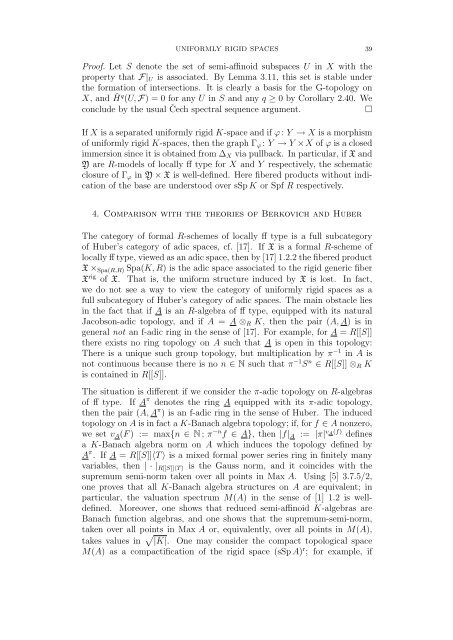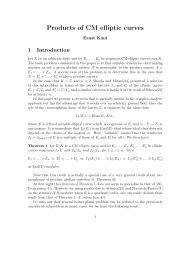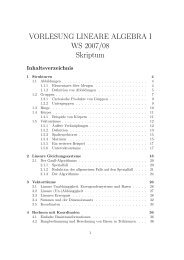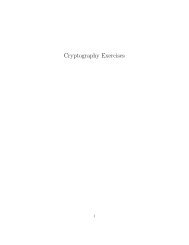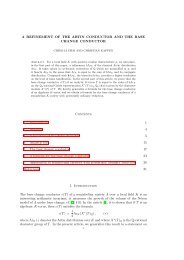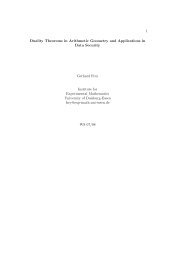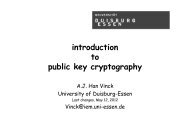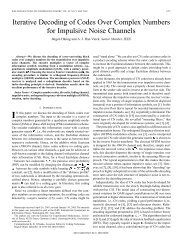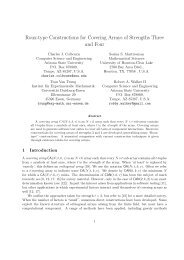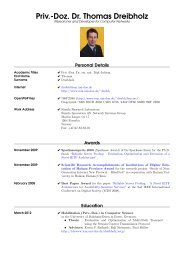UNIFORMLY RIGID SPACES 1. Introduction Let K be a non ...
UNIFORMLY RIGID SPACES 1. Introduction Let K be a non ...
UNIFORMLY RIGID SPACES 1. Introduction Let K be a non ...
Create successful ePaper yourself
Turn your PDF publications into a flip-book with our unique Google optimized e-Paper software.
<strong>UNIFORMLY</strong> <strong>RIGID</strong> <strong>SPACES</strong> 39Proof. <strong>Let</strong> S denote the set of semi-affinoid subspaces U in X with theproperty that F| U is associated. By Lemma 3.11, this set is stable underthe formation of intersections. It is clearly a basis for the G-topology onX, and Ȟq (U, F) = 0 for any U in S and any q ≥ 0 by Corollary 2.40. Weconclude by the usual Čech spectral sequence argument.□If X is a separated uniformly rigid K-space and if ϕ: Y → X is a morphismof uniformly rigid K-spaces, then the graph Γ ϕ : Y → Y ×X of ϕ is a closedimmersion since it is obtained from ∆ X via pullback. In particular, if X andY are R-models of locally ff type for X and Y respectively, the schematicclosure of Γ ϕ in Y × X is well-defined. Here fi<strong>be</strong>red products without indicationof the base are understood over sSp K or Spf R respectively.4. Comparison with the theories of Berkovich and Hu<strong>be</strong>rThe category of formal R-schemes of locally ff type is a full subcategoryof Hu<strong>be</strong>r’s category of adic spaces, cf. [17]. If X is a formal R-scheme oflocally ff type, viewed as an adic space, then by [17] <strong>1.</strong>2.2 the fi<strong>be</strong>red productX × Spa(R,R) Spa(K, R) is the adic space associated to the rigid generic fi<strong>be</strong>rX rig of X. That is, the uniform structure induced by X is lost. In fact,we do not see a way to view the category of uniformly rigid spaces as afull subcategory of Hu<strong>be</strong>r’s category of adic spaces. The main obstacle liesin the fact that if A is an R-algebra of ff type, equipped with its naturalJacobson-adic topology, and if A = A ⊗ R K, then the pair (A, A) is ingeneral not an f-adic ring in the sense of [17]. For example, for A = R[[S]]there exists no ring topology on A such that A is open in this topology:There is a unique such group topology, but multiplication by π −1 in A isnot continuous <strong>be</strong>cause there is no n ∈ N such that π −1 S n ∈ R[[S]] ⊗ R Kis contained in R[[S]].The situation is different if we consider the π-adic topology on R-algebrasof ff type. If A π denotes the ring A equipped with its π-adic topology,then the pair (A, A π ) is an f-adic ring in the sense of Hu<strong>be</strong>r. The inducedtopology on A is in fact a K-Banach algebra topology; if, for f ∈ A <strong>non</strong>zero,we set v A (F ) := max{n ∈ N ; π −n f ∈ A}, then |f| A := |π| vA(f) definesa K-Banach algebra norm on A which induces the topology defined byA π . If A = R[[S]]〈T 〉 is a mixed formal power series ring in finitely manyvariables, then | · | R[[S]]〈T 〉 is the Gauss norm, and it coincides with thesupremum semi-norm taken over all points in Max A. Using [5] 3.7.5/2,one proves that all K-Banach algebra structures on A are equivalent; inparticular, the valuation spectrum M(A) in the sense of [1] <strong>1.</strong>2 is welldefined.Moreover, one shows that reduced semi-affinoid K-algebras areBanach function algebras, and one shows that the supremum-semi-norm,taken over all points in Max A or, equivalently, over all points in M(A),takes values in √ |K|. One may consider the compact topological spaceM(A) as a compactification of the rigid space (sSp A) r ; for example, if


